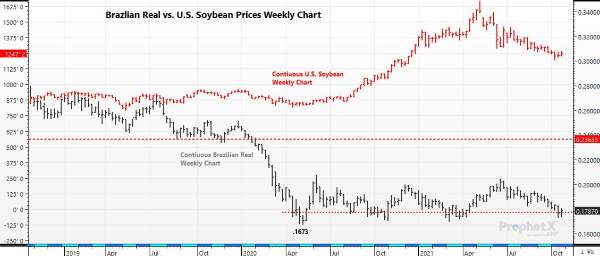MARKET SUMMARY 10-28-2021
The value of currencies can have an impact on the soybean market, and the current trend in the Brazilian real is pressuring the soybean futures prices. The Brazilian real value versus the U.S. dollar is challenging its lows for the year as overall concerns in the Brazilian economy have put pressure on its currency. Even despite efforts of the Brazilian government to raise benchmark interest rates, the currency valuation has not found much footing. The trend lower in U.S. soybean prices can be partially tied to the same trend in the currency value. The weak real makes the Brazilian soybean more competitive on the global market, and with anticipation of another record crop being planted for this spring, will act as a limiting factor in the soybean market.

Like what you’re reading?
Sign up for our free daily TFM Market Updates and stay in the know!
CORN HIGHLIGHTS: Corn futures closed firmer for the third day in a row gaining 2 to 5-1/2 cents as Dec led the way higher ending the session at 5.62-3/4. Strong gains in the wheat pit likely spilled over providing price support for corn, as did wet weather limiting harvest, and sharp gains this week for nitrogen prices. Weekly export sales at 35 mb were neutral.
The technical picture continues to look supportive with an upside objective of near 580 on Dec futures based on an inverted head and shoulders formation. As we talk with farmers, we get the sense they may be selling some corn but due to being busy with harvest or just putting corn in the bin, they’re not anxious to make sales. For many, cash flow is not a concern presently and they may not want to take income this year. That doesn’t mean they won’t forward contract for new year delivery, but for now with energy prices and fertilizer such big unknowns and talk of higher crude oil and nitrogen prices, many are standing to the sideline waiting for either better basis, higher futures, or both. For sure the market is experiencing multiple variables that make it confusing for price analysis. Yet, most of these variables have a friendly slant and consequently, the trade is buying corn futures while farmers remain light sellers.
SOYBEAN HIGHLIGHTS: Soybean futures rallied early in the session again as they have the previous two sessions, yet, like the last two days, couldn’t hold gains finishing with losses of 3 to 5-1/2 cents with Nov leading the way lower closing at 12.33-3/4. Soybean oil trades lower for the third day in a row. Crude oil suffered losses at mid-session which may have spilled over to soybeans.
Some thought that a lack of strong near-term export activity, along with large Chinese hog producers experiencing big financial losses may, in part, explain why prices are failing to hold rallies this week. Wet weather is supportive as harvest is again delayed in almost the entire Midwest. Export sales at 43.5 million bushels were supportive but considered old news. Year-to-date export sales at 1.118 bb, a strong number unless you compare it to this same time last year, are lagging well behind sales of 1.723 bb for this same week in 2020. Hand-to-mouth buying and expectations for big South American production (forecasted near 144 mmt in Brazil versus near 141 mmt in 2021) and more U.S. acres are keeping traders cautious. Some expect carryout to rise on the next USDA report as lower exports and higher yield are possible changes that will occur. Carryout could rise to between 350 and 400 mb.
WHEAT HIGHLIGHTS: Wheat closed higher on follow-through technical momentum and bullish fundamentals, as new high prices were again scored today for KC. Dec Chi wheat gained 12-3/4 cents, closing at 7.72-1/2 and Jul up 9-1/4 at 7.78-1/2 close to recent contract highs from earlier in the week. Dec KC wheat gained 7-1/4 cents, closing at 7.90, and Jul up 4-1/4 at 778-3/4. Dec MPLS closed at a new high of 10.37-1/2.
Wheat led the way again today despite a rough start to the session. Export sales were reported at 9.9 mb – approximately half of that went to Mexico. Exports are currently below the pace needed to meet the USDA’s export estimate of 875 mb. U.S. wheat exports, in general, have been performing poorly and are currently at 6-year low levels. Yesterday, Egypt bought wheat from Russia, Romania, and Ukraine, paying around $360 per ton. This was a higher price than their previous purchases. Rains today likely were a delay for SRW wheat plantings in the eastern Midwest. The Pacific Northwest remains drought-stricken despite some recent rains. Although down at the close today, Paris milling wheat futures remain near all-time highs. March KC wheat did manage to hit the $8 mark today and Dec came within 3 cents of that level. MPLS had nice gains today of 15-1/2 cents in Dec and 13-1/4 in Mar. There has also been a lot of news out of China that, while not directly impacting wheat, will impact the commodity markets. As an example, they are said to be cracking down on excessive speculative trading in energies and commodities. While this is not new news, it seems to be having an impact.
Total Farm Marketing and TFM refer to Stewart-Peterson Group Inc., Stewart-Peterson Inc., and SP Risk Services LLC. Stewart-Peterson Group Inc. is registered with the Commodity Futures Trading Commission (CFTC) as an introducing broker and is a member of the National Futures Association. Stewart-Peterson Inc. is a publishing company. SP Risk Services LLC is an insurance agency. A customer may have relationships with all three companies. TFM Market Updates is a service of Stewart-Peterson Inc. Futures and options trading involve significant risk of loss and may not be suitable for everyone. Therefore, carefully consider whether such trading is suitable for you in light of your financial condition.

